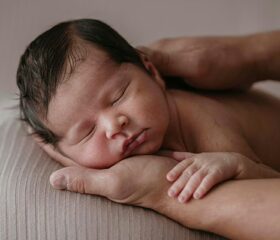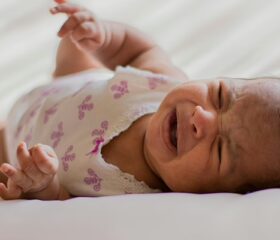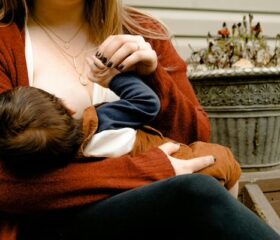How Often Should You Bathe Your Newborn?
Newborns are cleaner and require fewer baths than older children, as they’re less active.

- How often do newborns need baths?
- When should you give your newborn her first bath?
- How do you bathe babies with umbilical cord stumps?
- When will your baby be ready for regular baths?
- What bath temperature is safe for newborns?
- Tips to bathe your newborn in a bathtub safely
- How can you keep your newborn clean between baths?
- Final thoughts
Your sweet little one doesn’t sweat nearly as much as adults do, and she’s obviously not rolling around in the dirt—at least, not yet!
There’s no need to give her a bath every single day. In fact, frequent bathing could do more harm than good to her delicate skin.
Keep reading to learn how often your newborn needs a bath, when she should get her first bath, and a few tips to bathe her safely.
How often do newborns need baths?
Your newborn will only need three baths per week until her first birthday. 1
Don’t worry about her getting too sweaty or dirty. With a daily routine that mainly consists of eating and sleeping, newborns are much cleaner than toddlers and older children.
Some parents have the urge to bathe their newborn more frequently than the recommended amount; experts don’t recommend this. That’s because newborns have very sensitive skin, which can become too dry if you clean it too often.
You should also be careful about bathing your baby too frequently with soap. Somewhat counterintuitively, this can actually be bad for infant skin, as soap can destroy many beneficial (healthy) microbes on it, potentially leading to allergies and health issues like eczema, asthma, and infection.
When should you give your newborn her first bath?
The World Health Organization (WHO) suggests waiting at least 24 hours after birth before giving your newborn her first bath. Even after that, you should stick to giving her sponge baths (and not bathing her in a tub) until the stump of the umbilical cord falls off.
In lieu of a bath, immediately after birth, your nurse or midwife will wipe your baby clean and dry. 2
This day-long wait benefits your baby’s:
- Temperature regulation: Bathing newborns right after birth makes them more likely to develop hypothermia (when your body temperature is lower than 95°F or 35°C). 3
- Blood sugar stability: Again, baths can lower your baby’s body temperature, and it will take a lot of energy for her to get warm again. Burning this energy will drop her blood sugar, which is something you want to avoid right after birth. 4
- Breastfeeding success: You may have an easier time breastfeeding if you initiate skin-to-skin contact right after birth. This will trigger your hormones to produce more milk, which will help your baby feed in the early days. 4
- Skin condition: Healthy babies are often born with a waxy, white substance called vernix caseosa coated over their skin (although it also sometimes sheds before birth). 5 Experts suggest leaving this natural coating on babies for a while to keep their skin moisturized. This is especially beneficial to preemies who have even more delicate skin.
How do you bathe babies with umbilical cord stumps?
Your doctor will clamp your baby’s umbilical cord shortly after birth, and then someone will cut it (usually a nurse, although sometimes, you may be able to do it yourself). This will leave a stump, which can take about 5–15 days to dry and fall off. 6
Before it does, you should stick exclusively to sponge baths. 7 While the stump is intact, bacteria can easily get in, leading to infections. That’s why it’s important to keep the area clean and dry.
How should you give your baby a sponge bath?
Cleaning a newborn isn’t as complicated as you might imagine. Follow these steps to give your baby a sponge bath safely: 8
- Pick a warm room (about 75°F or 24°C) with a flat surface (e.g., a changing table or padded floor)
- Put a soft blanket or towel on the flat surface for your baby to lie on
- Prepare a basin of warm water, a washcloth, a dry towel, and a clean diaper and fresh clothes
- Keep your baby wrapped in a dry towel and only expose the body part you’re cleaning
- Dip the washcloth in the water, then wring out any excess water, leaving it damp but not soaking
- Gently wipe your baby, starting from her face to the rest of her body
- Wash her head with a dab of shampoo on a washcloth last (don’t brush your baby’s hair when it’s wet, as it’s prone to breaking)
You can add a little bit of non-fragrance baby soap to the water if you want. 7 Make sure to clean your baby’s skin creases and diaper area thoroughly and keep her umbilical cord stump dry when you bathe her. 1
Don’t worry if you notice “scales” when you wash your baby’s head
You might notice thick, yellowish scales on your baby’s scalp that may loosen when you wash her head. This is called cradle cap, which many newborns develop between 3 weeks old and 2 months old. It doesn’t usually need treatment and will typically disappear on its own when your baby turns 12 months old.
When will your baby be ready for regular baths?
As alluded to, your baby will be ready for regular baths once her stump has fallen off and the area has healed. Let the stump fall off on its own; keep it clean and dry, and don’t pull on it even if it’s barely hanging on. 6
When it comes to what time of day you should give her baths, there isn’t a “best” time to bathe your baby. 9 You can pick a time that fits your schedule, as long as it isn’t immediately after a feeding. Let her tummy rest for a while (15–20 minutes) before doing so to let the milk settle (so that she’s less likely to spit it up).
What bath temperature is safe for newborns?
You should bathe your baby in warm water (about 96–100°F or 36–38°C), not hot water. 8 Check if the water is too hot by dipping your wrist or elbow in it. Alternatively, you can use a bath thermometer that indicates “safe” bath temperatures.
Experts recommend setting your water heater temperature no higher than 120°F (48.9°C) so that you won’t accidentally burn yourself when testing the water. 1
Tips to bathe your newborn in a bathtub safely
The most important safety tip is to never leave your baby unattended, even for just a second. 2–3 inches of water is enough for a newborn’s bath, but babies can drown in less than 1 inch of water. 10
Keep accidents at bay by always keeping one hand on your baby as you bathe her. 11
In addition, you should:
- Buy bathtubs made recently: When you shop for an infant bathtub, check its product information label to see if it was manufactured after October 2, 2017. Infant bathtubs made before that date don’t comply with the latest federal safety regulations. 12
- Avoid using bath seats: Many bath seats that claim to support babies in adult bathtubs can tip over easily. What’s more, babies can slip out of them easily.
- Don’t use running water: If you prefer bathing your baby in a sink, turn off the faucet before placing her in it. Never bathe your baby in running water.
- Hold your baby safely: Support your baby’s head and neck throughout the bath. Keep most of her body and face well above the water, and pour warm water over her as you bathe her.
- Use unscented shampoo and body wash: Soap with fragrances might irritate your baby’s sensitive skin. 13
You can apply infant moisturizer to your baby’s skin after baths to prevent eczema (dry, red, itchy skin).
How can you keep your newborn clean between baths?
Although daily baths aren’t necessary, you can gently wipe your little one with a warm cloth in between bath times to keep her fresh and clean. 14
If there’s a particularly messy diaper situation, give your baby a quick “bottom soak.” To do so, just hold her in a seated position and wash the area with mild soap and water.
Final thoughts
Not having to bathe newborns every day is welcome news to parents who already have their hands full. Your little one will be perfectly clean and comfortable as long as you regularly change her diaper and clean her with a warm cloth in between baths.
Article Sources
- MedlinePlus. "Bathing an infant" Retrieved July 30, 2025.
- World Health Organization. "Caring for a newborn" Retrieved July 30, 2025.
- MedlinePlus. "Hypothermia" Retrieved July 30, 2025.
- Northwestern College Department of Nursing. "Delaying the Newborn Bath for Twenty-Four Hours" Retrieved July 30, 2025.
- MedlinePlus. "Skin findings in newborns" Retrieved July 30, 2025.
- MedlinePlus. "Umbilical cord care in newborns" Retrieved July 30, 2025.
- MedlinePlus. "Sponge bath" Retrieved July 30, 2025.
- University of Rochester Medical Center. "Bathing and Skin Care for the Newborn" Retrieved July 30, 2025.
- The Children's Hospital of Philadelphia. "Bathing and Skin Care" Retrieved July 30, 2025.
- University of Rochester Medical Center. "Infant Safety Tips" Retrieved July 30, 2025.
- UPMC Children's Hospital of Pittsburgh. "When Your Baby Is Home" Retrieved July 30, 2025.
- U.S. Consumer Product Safety Commission. "New Federal Safety Standard for Infant Bath Tubs Takes Effect" Retrieved July 30, 2025.
- Chicago Department of Public Health. "Common Newborn Health Issues" Retrieved July 30, 2025.
- Paediatrics & Child Health. "Skin care for your baby" Retrieved July 30, 2025.







